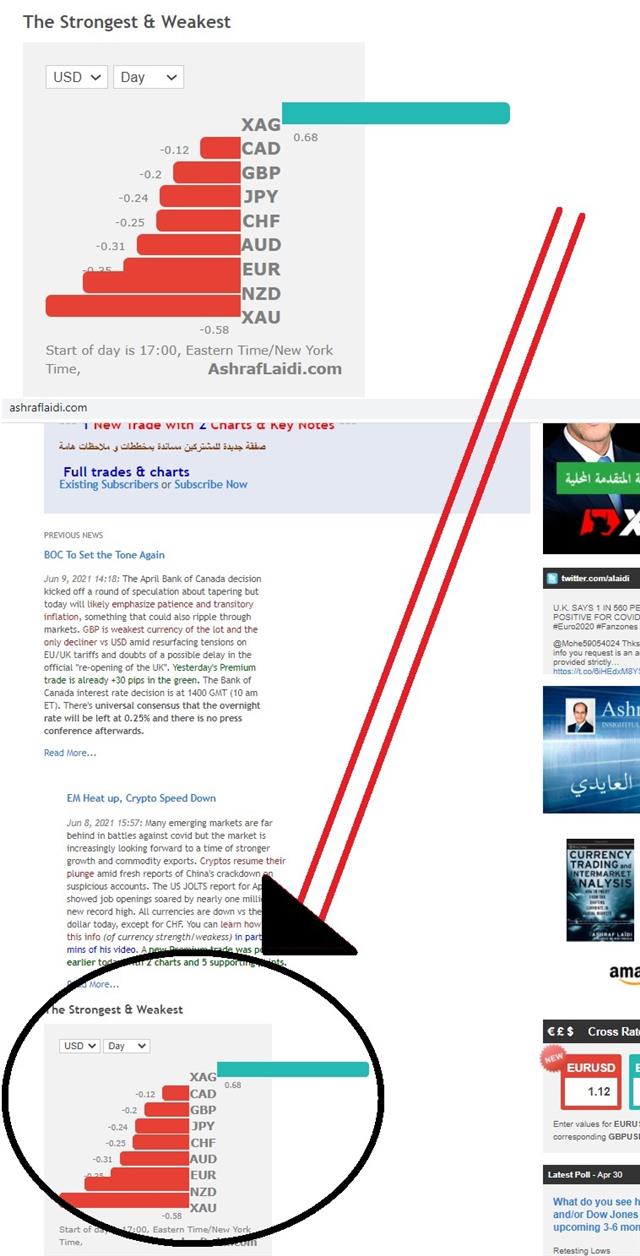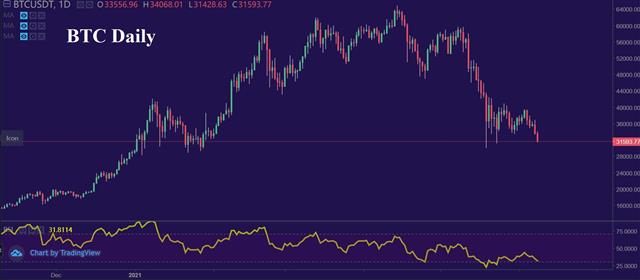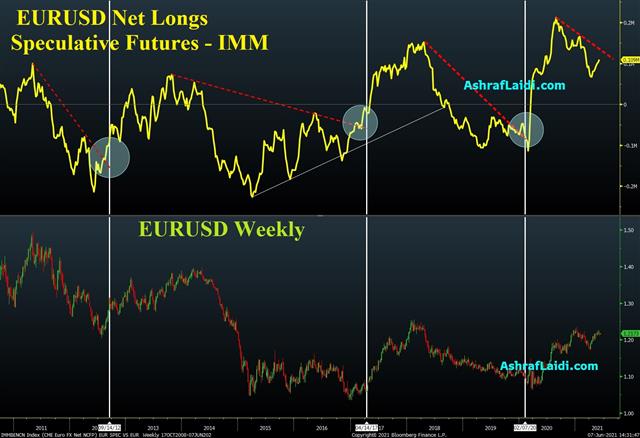Intraday Market Thoughts Archives
Displaying results for week of Jun 06, 2021Paradigm Persists, Yields Stabilize

Even though we anticipated dollar selling at some point after CPI, we were struck by the speed and aggressiveness of the move. CPI rose 5.0% y/y compared to the 4.7% consensus and core numbers were similarly strong. Despite that, the spike in the dollar lasted only minutes.
Shortly after the report, the dollar fell to session lows and kept on falling. Ultimately, the moves were modest on net but that they came after the highest CPI reading since 2008 is a sure sign that the market has embraced the Fed's transient view on prices.
More evidence of that continues to come from the bond market. Yields plunged sime more on Thursday with US 10s dropping another 5.9 bps to the lowest intraday since March. The cumulative move in the past week is now 20 bps.10-yr yield is now at 1.46%, off its latest 19-week low of 1.4266.
The power of the move makes is question whether we should be worried about economic weakness going forwards. Perhaps some of that reflects the US infrastructure impasse and pockets of rising covid cases, including in the UK.
There is also talk of a stumble in US consumer spending. To be sure, some decrease is anticipated because spending is roughly 15% above pre-covid levels in large part due to pent-up demand and stimulus cheques. A good barometer of the overall consumer mood is due on Friday with the preliminary UMich consumer sentiment numbers.Usual CPI Playbook?
May US CPI report at 1230 GMT/13:30 London/BST The headline is expected at 4.7% y/y with core prices up 3.5%. With numbers like that, it's astonishing that US 10-year yields are at 1.48% and down 15 bps from Thursday's close.
The message from the bond market increasingly aligns with the Fed's message: that it's all temporary. Even for the Fed though, that requires a leap of faith at an unprecedented time.
Perhaps some of the weight on yields is on the supply side. Congress is struggling to find any common ground on an infrastructure package and if the result is an impasse or much smaller package that would mean a lower deficit and less inflation-fueling growth.
The main driver in the day ahead though will be CPI. Estimates are tightly bunched around 4.7% and that suggests some degree of confidence. The fear is of a 5% print and that might have been responsible for some of the strength in the dollar Wednesday.
Don't forget the playbook from recent inflation numbers though. The prior CPI was a big upside surprise but the dollar rally was short lived. This time, the Fed is in the blackout period so they won't be able to push back but we're confident that they eventually will.BOC To Set the Tone Again

The only communication we will be getting is the press release and given everything that's happened since we last heard from the BOC, expectations for any kind of monetary shift are low.
The main reason none expects another hawkish surprise is due to the fact that the economy has undershot the BOC's April projections owing to harsh lockdowns in Canada's largest provinces. Both the market and the BOC will want to see how the economy looks in the reopening that's beginning now before taking another step.
One portion of the statement that could reverberate is on inflation. The latest BOC statement said “inflation is expected to rise temporarily to around the top of the 1-3 percent inflation-control range.”
The world 'around' gives them some leeway but the April number was already 3.4% y/y and prices have continued to rise so the BOC could alter that slightly to get ahead of it. They could simultaneously neutralize that shift by continuing to emphasized that the central bank “expects CPI inflation to ease back toward 2 percent over the second half of 2021” while highlighting base effects and capacity constraints.
The overall message would the be dovish as they underline temporary inflation and confidence to look beyond it.
That's the same message the bond market is sending with US 10-year yields falling a further 3.6 bps on Tuesday to 1.53% -- the lowest close since mid-March. Thursday's US CPI report will be another big challenge but if the market can shrug off another high print, then it will cement the belief that price rises won't last and rates can remain low through the Fed's projection horizon.EM Heat up, Crypto Speed Down

JOLTS rose by 998,000 to 9.3 million, reaching the highest since late 2000, but the data also showed people leaving jobs voluntarily.
Even in the early days of the pandemic, the market showed a remarkable ability to look towards the recovery and that's increasingly the case in emerging markets, which are many months behind developed markets in vaccinations and often without the fiscal capacity of G7 countries.
Looking over the past two months, the Brazilian real is the top performing global currency by a wide margin, followed by the South African rand. Both countries were ravaged by covid but will benefit from high commodity prices in the recovery. Virtually every EM currency is higher against the dollar in the past two months.
If this is the start of the economic cycle, then emerging markets are a great place to be. Ongoing fiscal and monetary stimulus in developed countries will feedback into demand for exports. Domestic economies will also stabilize once the pandemic passes.
Beware though of emerging markets that are large importers. Turkey and India are particularly vulnerable as higher prices could cause dangerous feedback loops and instability.
Markets are now set to prepare for Thursday's release of the US CPI repor, which is the last key data item before this month's FOMC meeting.Jobs Just Right

Non-farm payrolls rose 559K compared to 675K expected. The miss was even larger than it looked because the market had priced in something stronger after ADP and there were fears about a number close to 1 million.
With the miss, the entire ADP-inspired pop in the US dollar evaporated. Treasury yields fell sharply with 10s down 7.2 bps to 1.55% and threatening the low of the range since early March.
The average of the two most-recent jobs reports is 418K jobs. In normal times that would be great but the US needs to create 8-10 million jobs to get back to pre-pandemic levels. At that pace it would take 19 months to recoup that plus they need to create at least 200K jobs a month for demographic changes.
What's especially troubling is that April and May should have been the easiest months for the US to add jobs with lockdown measures ending.
For the market though, it's a near-perfect report. Jobs are still strong enough to have solid economic growth and there's no need to worry about a premature taper.
This week starts off light on the economic calendar but there will be major focus on Thursday's CPI report. We get the sense though that the market is coming around to the Fed's view: That high inflation numbers will be temporary.
CFTC Commitments of Traders
Speculative net futures trader positions as of the close on Tuesday. Net short denoted by - long by +.
EUR +109K vs +104K prior
GBP +24K vs +31K prior
JPY -47K vs -50K prior
CHF -0K vs -1K prior
CAD +49K vs +45K prior
AUD -2K vs -1K prior
NZD +6K vs +8K prior
That Nasdaq Fractal تنلظرية الناسداك
How we detected & executed that Nasdaq fractal starts at 14:32 mins of the video كيف وجدنا و نفذنا تناظرية الناسداك من 34:42 دقيقة من الفيديو








